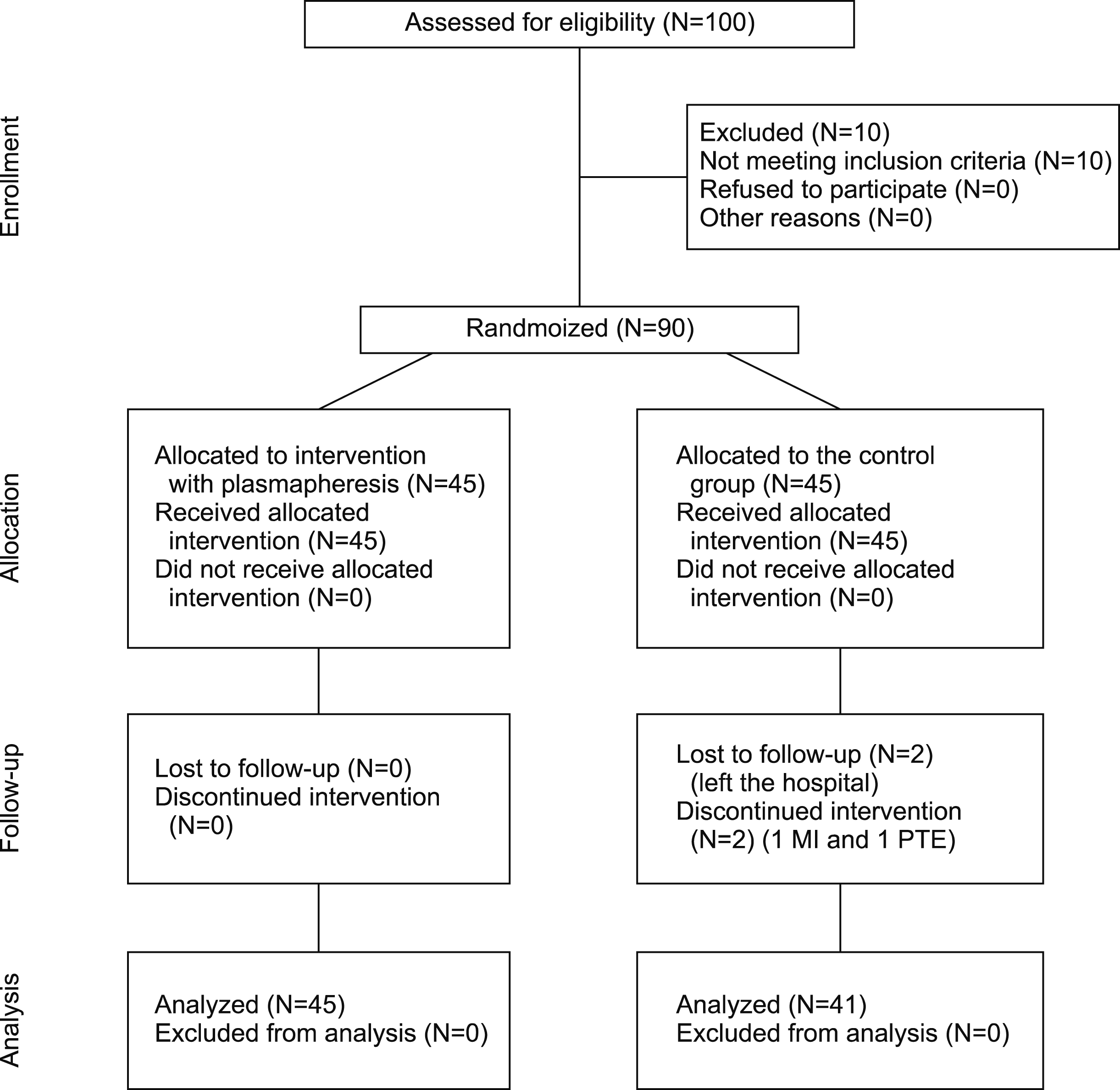2. Sadeghi S, Nasri P, Nasirian M, et al. 2022; On admission hemoglobin and albumin, as the two novel factors associated with thrombosis in COVID-19 pneumonia. J Renal Inj Prev. 11:9. DOI:
10.34172/jrip.2022.31957.

3. Wan Y, Shang J, Graham R, Baric RS, Li F. 2020; Receptor recognition by the novel coronavirus from Wuhan: an analysis based on decade-long structural studies of SARS coronavirus. J Virol. 94:e00127–20. DOI:
10.1128/JVI.00127-20. PMID:
31996437. PMCID:
PMC7081895.

4. Soy M, Keser G, Atagündüz P, Tabak F, Atagündüz I, Kayhan S. 2020; Cytokine storm in COVID-19: pathogenesis and overview of anti-inflammatory agents used in treatment. Clin Rheumatol. 39:2085–94. DOI:
10.1007/s10067-020-05190-5. PMID:
32474885. PMCID:
PMC7260446.

5. Sadeghi S, Nasirian M, Keivany E, Nasri P, Mirenayat MS. 2021; The demographic, clinical, and medical manifestations of pulmonary thromboembolism development in COVID-19. Blood Res. 56:293–300. DOI:
10.5045/br.2021.2021131. PMID:
34880142. PMCID:
PMC8721446.

6. Jordan RE, Adab P, Cheng KK. 2020; Covid-19: risk factors for severe disease and death. BMJ. 368:m1198. DOI:
10.1136/bmj.m1198. PMID:
32217618.

7. Chen N, Zhou M, Dong X, et al. 2020; Epidemiological and clinical characteristics of 99 cases of 2019 novel coronavirus pneumonia in Wuhan, China: a descriptive study. Lancet. 395:507–13. DOI:
10.1016/S0140-6736(20)30211-7. PMID:
32007143.

11. Sadeghi S, Keivany E, Nasirian M, Nasri P. 2021; On-admission versus in-hospital thromboembolism due to COVID-19 infection. What is the particular characteristic of those with early thrombotic events? Adv Respir Med. 89:484–92. DOI:
10.5603/ARM.a2021.0083. PMID:
34668181.

12. Balagholi S, Dabbaghi R, Eshghi P, Mousavi SA, Heshmati F, Mohammadi S. 2020; Potential of therapeutic plasmapheresis in treatment of COVID-19 patients: immunopathogenesis and coagulopathy. Transfus Apher Sci. 59:102993. DOI:
10.1016/j.transci.2020.102993. PMID:
33162341. PMCID:
PMC7605792.

13. Schwartz J, Padmanabhan A, Aqui N, et al. 2016; Guidelines on the use of therapeutic apheresis in clinical practice-evidence‐based approach from the writing committee of the American Society for Apheresis: the seventh special issue. J Clin Apher. 31:149–62. DOI:
10.1002/jca.21470. PMID:
27322218.

14. Szczeklik W, Wawrzycka K, Włudarczyk A, et al. 2013; Complications in patients treated with plasmapheresis in the intensive care unit. Anaesthesiol Intensive Ther. 45:7–13. DOI:
10.5603/AIT.2013.0002. PMID:
23572301.
15. Tabibi S, Tabibi T, Conic RRZ, Banisaeed N, Streiff MB. 2020; Therapeutic plasma exchange: a potential management strategy for critically Ill COVID-19 patients. J Intensive Care Med. 35:827–35. DOI:
10.1177/0885066620940259. PMID:
32666875. PMCID:
PMC7391476.

16. Kuriakose S, Singh K, Pau AK, et al. 2021; Developing treatment guidelines during a pandemic health crisis: lessons learned from COVID-19. Ann Intern Med. 174:1151–8. DOI:
10.7326/M21-1647. PMID:
34125574. PMCID:
PMC8252833.

17. Marik P. 2020. EVMS critical care Covid-19 management protocol. Eastern Virginia Medical School;Norfolk, VA:
18. Saeed GA, Gaba W, Shah A, et al. 2020; Correlation between chest CT severity scores and the clinical parameters of adult patients with COVID-19 pneumonia. Radiol Res Pract. 2021:6697677. DOI:
10.1101/2020.10.15.20213058.

19. Yang X, Yu Y, Xu J, et al. 2020; Clinical course and outcomes of critically ill patients with SARS-CoV-2 pneumonia in Wuhan, China: a single-centered, retrospective, observational study. Lancet Respir Med. 8:475–81. DOI:
10.1016/S2213-2600(20)30079-5. PMID:
32105632. PMCID:
PMC7102538.

21. Wang Y, Zhang D, Du G, et al. 2020; Remdesivir in adults with severe COVID-19: a randomised, double-blind, placebo-controlled, multicentre trial. Lancet. 395:1569–78. DOI:
10.1016/S0140-6736(20)31022-9. PMID:
32423584. PMCID:
PMC7190303.
22. Molina JM, Delaugerre C, Le Goff J, et al. 2020; No evidence of rapid antiviral clearance or clinical benefit with the combination of hydroxychloroquine and azithromycin in patients with severe COVID-19 infection. Med Mal Infect. 50:384. DOI:
10.1016/j.medmal.2020.03.006. PMID:
32240719. PMCID:
PMC7195369.

23. Rosca A, Balcaen T, Lanoix JP, et al. 2022; Mortality risk and antibiotic use for COVID-19 in hospitalized patients over 80. Biomed Pharmacother. 146:112481. DOI:
10.1016/j.biopha.2021.112481. PMID:
35062049. PMCID:
PMC8712262.

24. Hassaniazad M, Vahedi MS, Samimagham HR, et al. 2021; Improvement of clinical outcome, laboratory findings and inflammatory cytokines levels using plasmapheresis therapy in severe COVID-19 cases. Respir Med. 189:106669. DOI:
10.1016/j.rmed.2021.106669. PMID:
34757278. PMCID:
PMC8547850.

25. Adeli SH, Asghari A, Tabarraii R, et al. 2020; Therapeutic plasma exchange as a rescue therapy in patients with coronavirus disease 2019: a case series. Pol Arch Intern Med. 130:455–8. DOI:
10.20452/pamw.15340. PMID:
32380821.
26. Dogan L, Kaya D, Sarikaya T, et al. 2020; Plasmapheresis treatment in COVID-19-related autoimmune meningoencephalitis: case series. Brain Behav Immun. 87:155–8. DOI:
10.1016/j.bbi.2020.05.022. PMID:
32389697. PMCID:
PMC7204750.

28. Rimmer E, Houston BL, Kumar A, et al. 2014; The efficacy and safety of plasma exchange in patients with sepsis and septic shock: a systematic review and meta-analysis. Crit Care. 18:699. DOI:
10.1186/s13054-014-0699-2. PMID:
25527094. PMCID:
PMC4318234.

29. Yang XH, Sun RH, Zhao MY, et al. 2020; Expert recommendations on blood purification treatment protocol for patients with severe COVID-19. Chronic Dis Transl Med. 6:106–14. DOI:
10.1016/j.cdtm.2020.04.002. PMID:
32346492. PMCID:
PMC7186198.
31. Schwindenhammer V, Girardot T, Chaulier K, et al. 2019; oXiris® use in septic shock: experience of two French centres. Blood Purif. 47(Suppl 3):1–7. DOI:
10.1159/000499510. PMID:
30982028.

32. Bucciarelli S, Espinosa G, Cervera R, et al. 2006; Mortality in the catastrophic antiphospholipid syndrome: causes of death and prognostic factors in a series of 250 patients. Arthritis Rheum. 54:2568–76. DOI:
10.1002/art.22018. PMID:
16868979.

33. Novacescu AN, Duma G, Buzzi B, et al. 2022; Therapeutic plasma exchange followed by convalescent plasma transfusion in severe and critically ill COVID‑19 patients: a single centre non-randomized controlled trial. Exp Ther Med. 23:76. DOI:
10.3892/etm.2021.10999. PMID:
34934447. PMCID:
PMC8652389.

34. Donnelly SC, Strieter RM, Kunkel SL, et al. 1993; Interleukin-8 and development of adult respiratory distress syndrome in at-risk patient groups. Lancet. 341:643–7. DOI:
10.1016/0140-6736(93)90416-E. PMID:
8095568.

35. Wang R, Pan W, Jin L, et al. 2020; Human papillomavirus vaccine against cervical cancer: opportunity and challenge. Cancer Lett. 471:88–102. DOI:
10.1016/j.canlet.2019.11.039. PMID:
31812696.

36. Hashemian SM, Mortaz E, Tabarsi P, et al. 2014; Elevated CXCL-8 expression in bronchoalveolar lavage correlates with disease severity in patients with acute respiratory distress syndrome resulting from tuberculosis. J Inflamm (Lond). 11:21. DOI:
10.1186/1476-9255-11-21. PMID:
25110464. PMCID:
PMC4126912.





 PDF
PDF Citation
Citation Print
Print



 XML Download
XML Download